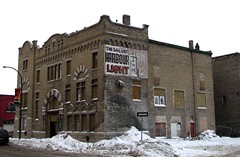January 8, 1936, Winnipeg Tribune
While researching the Thelmo Mansions apartments on Burnell Street I came across a rather remarkable resident: Eva Leadbetter of the Salvation Army. For two decades she tended to the city's poor, oversaw the production of tens of thousands of pieces of clothing and even bought a needy family a house from her life savings.
A Salvation Army source told the Tribune in 1942 that "We just call her our saint. She is the most dedicated worker we have." Here is a look at the Saint of Burnell Street.
Leadbetter was born in 1882 in Midway, Massachusetts and attended school in North Dakota. Her family moved near Prince Albert, Saskatchewan before she came to Winnipeg in 1922 to enter the officers' training college of the Salvation Army. (She may have had relatives in the Army, as around the same time she was in college there was a Captain Leadbetter who worked at the Weston Corps.)
It was during the Depression that Leadbetter made her mark on the city.
In 1932 she became coordinator of the Salvation Army's Fresh Air Camp at Sandy Hook. Each summer between 500 and 600 inner-city children and their mothers were given a two-week getaway. The aim was to promote healthy lifestyles and to provide a break from the stress and heat of the city's slums.
Leadbetter was Sandy Lake Camp's coordinator for over a decade. It was in existence until the 1970s. (For more on the Lake Winnipeg Fresh Air Camps.)
May 9, 1936, Winnipeg Free Press
The
camp, though, was a seasonal job. Leadbetter's main responsibility was
to make home visitations to needy individuals and families in Winnipeg's
slums. When she found someone in desperate need she was known to
literally move in and to tend to them until the assistance they
required arrived.Seeing first-hand that the basic needs of people were going unmet, she created the Helping Hands League in 1931.
The organization repaired or made clothing, quilts and blankets for the needy. The group started with a dozen women from all religions and walks of life and four sewing machines set up in Leadbetter's apartment, 27 Thelmo Mansions. In the 1932 - 33 season their inventory included: "garments made - 1,021, Stockings knit - 219, shoes provided - 83 pair, quilts made - 58, sheets made - 37, crib outfits - 5."
Helping Hand League, Jan 5, 1946, The War Cry
Aside from producing the items, Leadbetter also raised funds, collected the required materials and arranged for their distribution. Within a couple of years the Salvation Army provided her with an annual stipend to cover costs and other organizations donated supplies.
By 1936 the League had 70 women at work with a dozen sewing machines and other equipment all set up in Leadbetter's apartment !
When the Depression was over, the League carried on tending to the poor and war-widowed families as well as knitting caps and scarves for the soldiers. By this time they had moved to a Salvation Army facility.
In May 1942, realtor and alderman C. E. Simonite contacted the Tribune to tell of his encounter with Eva Leadbetter earlier in the month:
"She
came into my office and she offered to put her entire life savings,
amounting to $200, to help buy a home for one of the deserving families
forced to seek temporary lodging from the city early in May.”
The evicted family had 8 children, making them difficult to house. Leadbetter laid out the size of house required and what parts of town would be acceptable. She offered to match the family's monthly payment of $20 with $10 a month from her Salvation Army stipend until the house had been paid off.
September 29, 1954, Winnipeg Free Press
Leadbetter's trademark was her bicycle. She did all
of her work, including deliveries, with it. It is said that she could easily clock 30 miles a day.Aside from her daily visitation duties and evenings with the Helping Hand League, she also taught Sunday school for two decades at the Weston Corps of the Salvation Army. Working with children and youth was the mainstay of her 50-plus year career.
Leadbetter worked in Winnipeg into her 70s, when she typed and transcribed material for the Grace Hospital's nursing school before starting her visitation duties. In 1954, however, she announced that she was retiring to Kelowna B.C.. The "angel of the Gateway City" was moving on.
She spent just a short time in Kelowna before moving to Victoria and becoming active with the Salvation Army again. She did home visitations, (still on a bike), and taught Sunday school well into her late eighties.
In 1962 the Salvation Army presented Leadbetter with a Certificate of Recognition for Exceptional Service for her “years of faithful, sacrificial and loving service." (November 7, 1962 War Cry.)
Eva Leadbetter died in Victoria B.C. on January 16, 1976.
Related:
History of Salvation Army in Canada Salvation Army
Salvation Army and Citadel Historic Buildings Committee
Winnipeg Evening Tribune, November 13, 1942






















No comments:
Post a Comment